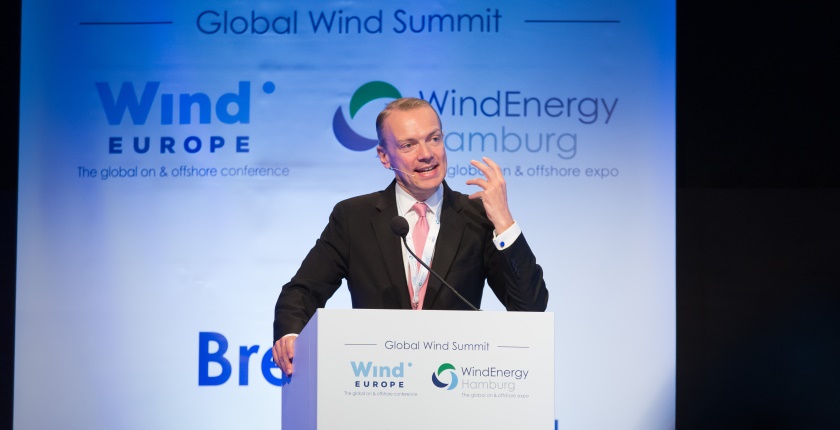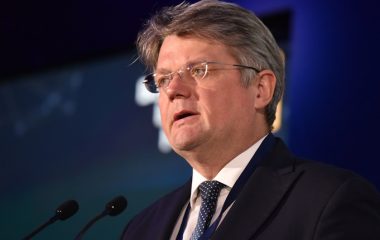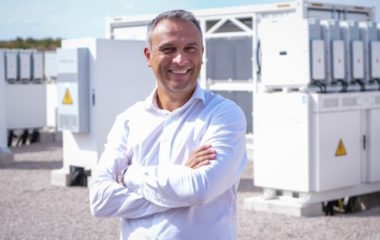
WindEurope
Energy-intensive companies like steel, chemicals and cement producers see that renewables are the cheapest form of energy and that they became much more reliable, WindEurope’s Chief Executive Officer Giles Dickson said. In an interview with Balkan Green Energy News, he expressed confidence wind can meet the EU’s target of providing 50% of electricity in 2050 and stressed contracts for difference or CfDs are the preferred model for the development of wind power plants.
Giles Dickson is at the helm of WindEurope since 2015. It represents more than 400 members throughout the value chain of the onshore and offshore wind power industry. Among other activities, WindEurope coordinates publicly funded research and development. Dickson is also chairman of the independent Advisory Council of ENTSO-E, the European Network of Transmission System Operators for Electricity.
How much room is there for the expansion of wind power given that coal would eventually be out of the picture? In that sense, how important are the expansion of electric vehicles and the expected transition in much of the industry and even heating to electricity?
Wind provides 16% of the electricity we consume in the European Union, but it varies from country to country. For instance, the level is 50% in Denmark and it is 27% in Germany.
The European Union wants wind to make up 50% of Europe’s electricity in 2050, but they also want the share of electricity in the entire energy mix to increase from less than one quarter today to three quarters by mid-century. Then 57% would be from the direct electrification of industrial processes, transport, heating and so on, and 18% would come from renewable hydrogen and its derivatives.
Car manufacturers believe electric vehicles would cost the same as the ones with internal combustion engines already in 2026
The total capacity of wind generation we have in the EU is 180 GW, and the European Commission has said we need 1,300 GW by 2050. It would be a huge increase. Solar would have a share of 25% to 30% in the EU’s electricity.
Car manufacturers are saying that electric vehicles will cost the same as those with internal combustion engines already in 2026. The European Commission proposed to cease the sale of combustion engine vehicles by 2035.
We think that the rate of electrification of heating in commercial buildings will be 60% by 2050, compared to 45% in residential buildings. We think that the share in rail transport will be 100%.
With today’s technology, 76% of Europe’s industry can be directly electrified
Crucially, if you look at all those sectors of industry that are heavy consumers of energy, and most of it is fossil energy, the scope for electrification there is huge. With today’s technology you can directly electrify 76% of Europe’s industry.
A lot of these energy-intensive sectors, like steel, chemicals and cement, are knocking on our door as they want to decarbonize. They see renewables are the cheapest form of energy and that we are much more reliable than we used to be.
Increasingly, when we are building a wind farm, we are thinking about who will be consuming the electricity. One of our members in France, for example, is developing a network of 85 fast-charging stations for electric vehicles around the motorway network in the country. Each will have up to 40 charging points. The company will install one or two wind turbines next to the motorway and the charging station.
But certain things have to happen to reach the EU target. We have to keep investing in our electricity grids. We have to make sure that we are taking a simple, common sense approach to the permitting of new wind and solar facilities. Generally, the permitting rules and procedures across Europe are too complex. It takes too long.
What is the solution to the intermittence issue? Winds can be too weak to meet the power demand at times, or too strong. How much do you count on storage and demand response?
The capacity factors of wind turbines have increased significantly in recent years. They are operating more steadily and they are generating electricity at lower wind speeds than they used to.
Wind turbines are now much more flexible as well. When there is more wind in the system than there is demand, we can ramp down production more quickly than we used to be able to. Conversely, we can ramp up production more easily than before.
The EU has 40 GW of demand response capacity in operation. The target is to have at least 100 GW by 2030. That is more variable demand helping to balance the more variable supply. It helps the system and the markets work.
Grids can handle renewable energy capacity without massive investments in storage
Then we have storage. It is quite common for battery units to be installed when wind farms are built. They are storing electricity for balancing the grid, for frequency and voltage control and other ancillary services.
How far can you go in any one country? I think the best example is Ireland. The grid and electricity system there can now accommodate up to 75% variable renewables at any point in time.
The government achieved that by creating markets through auctions for all these services that I mentioned, without having invested a huge amount in storage. They are investing a lot in the grid and in demand response. This can be done.
You have said contracts for difference or CfDs need to become the standard model for support for renewables in Europe. What is the current situation?
More and more countries are introducing the CfD model. It is the auction system for offshore wind in the United Kingdom, France, Poland and Denmark, and it will be in Greece and in Lithuania.
Only Germany and the Netherlands operate a different system, which allows for zero bidding. It means higher financing costs and higher costs for society.
Public financial support no longer means subsidies. It means revenue stabilization.
You win the auction with the lowest price. With a CfD, if the market price is lower than your auction price, the government pays you the difference. If it’s higher, you pay the difference to the government. You do not pocket it. Governments are getting paid back as well as paying up. It’s not a subsidy.
Contracts for difference lower financing costs for developers of renewable energy projects, which means electricity will be cheaper
In the UK they are about to do the world’s largest renewables auction ever, 12 GW of renewables capacity, most of which is wind. And it’s going to be CfD.
CfDs are cheap for society as a whole because they mean lower financing costs. A developer which has a CfD contract can show a bank that it has guaranteed revenue over 15 years and get a loan at a low interest rate to buy the turbines for the project.
If the company doesn’t have a CfD, it depends on the wholesale electricity price, which is variable, and the bank doesn’t like that.
Let’s say a wind farm with a CfD has a levelized cost of electricity, LCOE, of EUR 50 per MWh over its lifetime. The same wind farm without a CfD will have LCOE of EUR 92 per MWh.
What are the benefits for the wind power industry within the European Green Deal?
The European Green Deal means reaching net carbon neutrality by 2050, which means the energy system must be decarbonized by the electrification of the energy system and a huge increase in renewable electricity – whether it’s for direct consumption or indirect consumption as renewable hydrogen or other renewable gases.
We want to accelerate the recovery of the EU economy post-COVID and the injection of recovery money creates new sources of investment for a lot of the supporting infrastructure that we need for the expansion of wind energy. I am thinking of the electricity grids and also port infrastructure for the expansion of offshore wind.
The European Green Deal and pandemic recovery funds are sources of investment for infrastructure necessary for the expansion of wind energy
Last week the EU’s Innovation Fund supported some airborne wind projects. The funds even predate the European Green Deal. Its all about the commercial scaleup of technologies. The Modernization Fund also has an important role, for energy infrastructure and industrial infrastructure.
It is important to say that floating offshore wind has now come of age. It is on the cusp of large-scale commercialization. France is now in the middle of the world’s first large-scale floating offshore wind farm auction, for 250 MW.
In Southeastern Europe, Greece is preparing the legal framework for offshore wind power with strong ambitions. Turkey and Romania are also making efforts in that direction. What are your expectations for the region?
The Romanian government is thinking of introducing CfD auctions for offshore wind farms. It is talking to the European Bank for Reconstruction and Development about what the best design is. In Greece they are very clear that for their first round of offshore wind farms it has to be CfD auctions. That is what they are using for their onshore wind auctions now. The first auction should be held next year.
Bulgaria and Romania both included significant amounts in their recovery and resilience plans for investments in electricity grids, which is very positive.
The closest good example to your region is Saipem’s 450 MW project in the Adriatic Sea. Not least because it’s for the production of renewable hydrogen.
We have seen situations where consumers get free electricity from wind at times when there is too much power supply in the system. Will the situation change with the emergence of energy storage solutions, so producers can sell power when demand is higher?
There is no concern for oversupply. A situation where we don’t have enough renewables is more likely.
The German chemical industry alone will have electricity demand in 2050 that is higher than in all of Germany right now. What we will see is companies moving to renewable energy hubs. There are wind farm clusters in the north of Germany where sometimes you have oversupply. But big data centers might just relocate to such places, for instance.
Companies have understood the value of cheap and clean renewable electricity.
Does climate change alter wind patterns? Are there situations where wind becomes much weaker than in the studies for locations for wind power plants?
We follow the science on this very closely and the broad consensus is that climate change is not impacting the availability of wind as a renewable energy source. When you build a wind farm, you have to get your long-term resource assessment right. Resource assessment experts are doing their job and their forecasts have proved to be reliable.
We are seeing, of course, some extreme weather conditions and output might go up or down by 15%. With a greater incidence of extreme weather conditions, it’s posing some challenges to those who are trying to forecast a predictable and steady output. But total output over the lifetime of a wind farm is still what we have expected.









Be the first one to comment on this article.